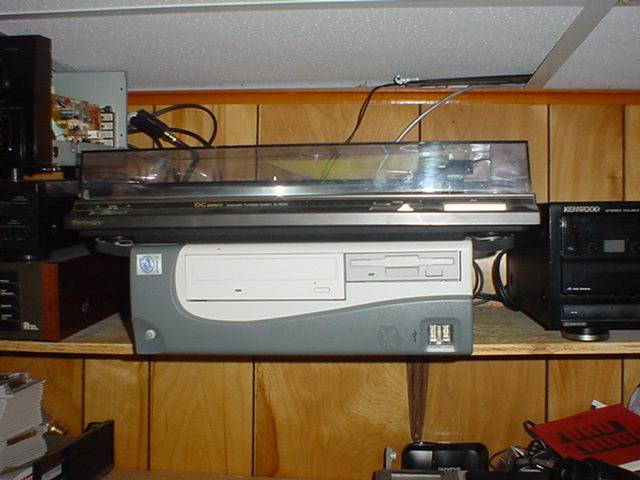Poor & Lazy Man's Music Player

I've always wanted to have a computer of some kind that would
fit on my shelf of stereo equipment and have the ability to play music directly
into a line input on the stereo.
I've seen lots of neat systems
constructed, and I always wanted to build one of my own, but unfortunately time,
lack of confidence in my skills and being as cheap as I can be have prevented me
from becoming ambitious enough to actually build such a music player.
I
recently decided on a different idea--using a prebuilt computer on the stereo
shelf. Trouble is, very few computer systems are the size of an "average" piece
of stereo equipment. Often the cases of even a small desktop PC are quite large
and space on my stereo shelf is at a premium.
A Macintosh G4 "cube" might
have been nice, and certainly would have had style, but those things are
expensive even today! Instead I used a Gateway PC with a very slim form factor.
(I don't know the exact model, but Gateway calls the motherboard inside a
"Brookings" board if you want to try and find one...) This system wasn't quite
functional--at some point the hard disk inside failed and the system was
"scrapped" in favor of something a bit more repairable and capable of taking
standard sized option cards. Eventually it got nearly parted out and donated
quite a few things to other computers that needed them more.
I wanted to
rebuild it especially for this purpose and to do so was very time consuming. I
had to locate every piece that I'd taken off and stored. Naturally this took
quite a bit of time. I also had to fabricate new IDE and disk drive cables. All
of this was fairly easy to do. I found a grey floppy disk drive from a scrapped
HP Vectra Pentium Pro. At first I wanted to use a 40GB Western Digital drive in
the computer, and the BIOS did see it, but it failed POST no matter what. I
think the drive was too big for the computer and "disk manager" software has
never worked for me with Windows NT/2000 anyway. So I settled for a 2.1GB
Seagate drive that had been gathering dust for a while. Sure, it is small, but
all the machine is playing are audio files stored on other computers on my
network.
In the rare event that I would need more storage space for any
reason, I took a DVD-ROM drive that was also gathering dust and installed that
in place of the original CD-ROM drive. With the DVD-ROM in place, I can simply
burn a DVD containing all the music I own copies of.
Once I had the
machine basically functional, I loaded Windows 2000 Professional on it, since
that is the only way to run Apple's iTunes. (Okay, it's the only supported as
per Apple way. Maybe there are ways to run it on earlier versions of
Windows. I do not know and haven't researched it.) This wasn't too hard, but I
learned that disk I/O performance is key with Windows 2000, more so than on
Windows NT 4 as I remember it. The 2.1GB drive was a little slow, but after
defragmentation the performance is acceptable.
Networking the machine was
somewhat entertaining. I elected to go with wired networking to help avoid the
chance of any audio interference getting into my stereo receiver. This Gateway
computer uses standard PCI slots, but all of the card openings in the rear are
not regular size. I've never seen slots with reduced size openings before.
Thankfully the D-Link DFE-530TX NIC that I chose comes with a rear bracket that
is a perfect fit for this machine.
Since space on the stereo shelf is at
a premium, I elected to run the computer without a keyboard, mouse or monitor
attached. I only have to attach the keyboard and mouse to boot the computer...it
will produce POST errors if they are not both attached. Once everything has
booted up, they are not required. In the rare event that direct input would be
needed to do something on the computer, the keyboard and mouse are both USB and
have no problem being hot-plugged. I use RealVNC to control the computer from any
point on my household network. Should I want to turn the computer off, simply
pressing the power button once gets Windows 2000 to shut down in an orderly
way.
Getting the audio into the stereo was easy. All I needed was a cable
with RCA plugs on one end and a stereo minijack on the other end. These are
available everywhere and I have quite a collection of them.
That's pretty
much all there is to it. While I realize that this project lacks the creativity
and pride that would be taken in something I would have built myself, it was
still an interesting project and the end result turned out much better than I
hoped for, especially since the computer in question is more or less a standard
PC.
Oh, and did I mention that when it isn't entertaining me, it is
running Distributed.net around the
clock?
Go Back>
Copyright 2004 by Walsh Computer Technology. All Rights
Reserved.
